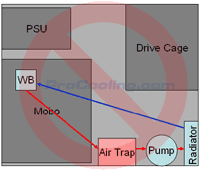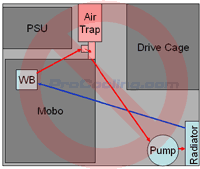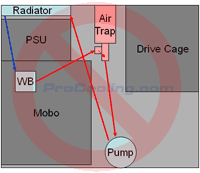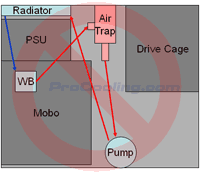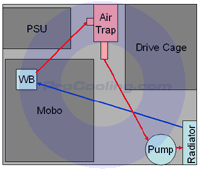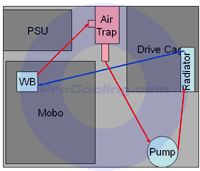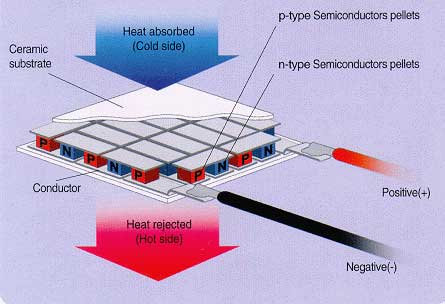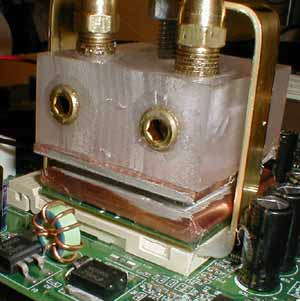|
|
|
|
 Cooling Technologies Explained Cooling Technologies Explained
|
|
Date Posted: Feb 16 2002
|
|
Author: The ProCooling Team
|
|
|
|
|
Posting Type: Article
|
|
Category: FAQ's, Editorials, Q&A's
|
|
Page: 6 of 8
|
|
Article Rank:No Rank Yet
Must Log In to Rank This Article
|
|
|
|
|
Note: This is a legacy article, imported from old code. Due to this some items on the page may not function as expected. Links, Colors, and some images may not be set correctly.
|
|
|
Cooling Technologies Explained By: The ProCooling Team
|
|
3/24/02 - Team Article - By: Brian, Brad, pHaestus and Joe
|
|
|
|
|
|
Water Cooling -(Cont.) By: Joe
|
|
Parts of a Water Cooling System -
|
|
|
Reservoir / Air Trap- This is a rather optional part of a cooling loop, but plays a very important role for the longevity of your cooling system. What they do is act as a spare coolant pool, and in the process let any trapped air bubbles escape the coolant before returning to the cooling loop. Air is the arch enemy of our cooling systems! If you have enough air in your system your pump could stall out, your block could loose most of its effective heat transfer capabilities cause it may be full of air, and also it will encourage bacteria growth. When I say it can stall a pump that's cause our pumps are Centrifugal style. That means there is an impeller spinning around fast, this action literally spins the water around in the impeller housing to the point that it picks up momentum and is shot out to the top of the pump ( side of the impeller). There is much more at work, but that's the simple explanation. So when air gets into the impeller housing, the impeller sloshes around with water and air bubbles breaking up the whole spinning cycle that was happening. Eventually the pump will just cavitate and not push any water out or very little. (this is also very harmful for the pump.)
Ok with that said, we know its bad to have air in the system. To get it out you need to have some thing to grab the air and let it escape. If you have a sealed closed loop system with no place for air to go, it will collect in the pump, or water block or radiator, or other highest points in the system. This is going to be a long part of this article simply because of all the incorrect designs I see around the web.
|
|
Wrong ways to run an Air Trap:
|
|
|
|
|
|
For an air trap to work well, it must be the highest item in a system. It really doesn't matter where in the loop it is, as long as its at the highest point in the cooling system. If its not, it will more than likely NOT trap air as designed but will let the WaterBlock act as an air trap ( which is NOT what we want).
|
|
|
|
|
|
|
Now with the Air trap above everything else, if you don't run the coolant THROUGH the air trap, the air will not get trapped. The velocity of the coolant is normally enough to hold the air bubbles in it even if you have a "T" right under the air trap. In almost all cases a "T" junction will never work well as an air trap. If it does trap any air it will only be because of some air accidentally going into it, and may take weeks for you to bleed a system like this.
|
|
|
|
|
|
|
In this one not only is the Air Trap not the highest point in the cooling system, but the coolant is not even going through the air trap still. This is about the worst of all worlds. Now you have no real possibility of air going into the air trap and you have a radiator that is more than happy to hold all the air you give it.
|
|
|
|
|
|
|
Ok Now we are running the coolant though the air trap, but its no longer the top of the coolant loop. The radiator is now the air trap. Radiators seem to hold air real well which is real bad in this kind of setup. You can loose close to 30 - 50 % of your coolant to metal surface contact if you have too much air in your radiator!
|
|
|
Right ways to run an Air Trap:
|
|
|
This is a good setup. Now you are running the coolant through the air trap, and since its the highest point in the cooling system there is no worry about the air trying to collect in the other devices. This acts as a 24/7 bleeder on your system. Any air that may get into it, is instantly pulled out and bubbled up in the air trap. A key point is to make the intake and the exhaust fittings on the air trap separated and so there is no direct path that the air could be sucked down the exhaust fitting back in the system.
|
|
|
|
|
|
You can move the radiator all over in the machine and even more the air trap around, as long as you keep it as the highest point in the machine. (keep the radiator or other objects below the water line in the air trap).
|
|
|
|
With all that said, you can run a reservoir at the bottom of the system and a air trap at the top also. Since many people use the submerged pumps we talked about earlier, you could keep that at the bottom and put the air trap at the top. Air traps function as reservoirs in most cases also, so additional coolant storage in the system really isn't needed.
|
|
Coolant Lines / Hose- This is an area that we more than likely will not have to talk about much, and the endless debate of Vinyl vs. Silicone won't be settled here either. You need to figure out what qualities you need and what you want from the hose. If you are looking for something that looks better but need to be replaced more often, well Vinyl is the way to go. If you are looking for something that is more industrial, harder to kink, and overall more durable, then silicone is the way to go.
Special hose like steel braided, or nylon braided reinforced hose can be used but is truly impractical for most systems. Tygon, Latex, PVC, Nylon, Rubber, Copper Pipe, and Stainless Steel flex hoses are all other options you can look into. They all have their own benefits and flaws, since each system is different you may have needs that the normal silicone or vinyl cant handle.
The main factor to look at for your hose is the Internal Diameter. Are you going to run a 1/4"? or 3/8" or 1/2" system? Really I believe that 3/8" is perfect for most "in case" systems. ( systems that are totally contained in a computer case). This is also a question of how powerful of a pump do you have?. The math is every time you double the internal diameter of a piece of hose you decrease the resistance for a given amount of coolant by a factor of 16. That's some serious flow restrictions, but it only matters if you are trying to get 500 - 700 Gph in you lil case. If you are just going to push 120 GPH or so through the system, 3/8" will do just great! See flow resistance only becomes a factor when the back pressure starts to build on the pump. If the lines are big enough for the given flow rate that you want, then you have nothing to worry about. Heck in some cases you could get away with 1/4" just fine.
One area that bigger diameter hose helps is with long hauls. If you have a long segment of hose to a radiator and pump that's 10 ft away from your case, you will want some big lines there so it lowers the overall resistance of the flow for that distance.
|
|
Overall Cooling System Design-
|
|
From what you just read, its pretty clear I think that the entire cooling system has to be designed as one piece. Since the right WaterBlock needs to be picked for the right pump which needs to be picked for the right hose, etc...
When you design a water cooling system here are some goals and requirements I have made up for any systems I design:
- Must not introduce the exhaust air from the radiator back into the case - Hot Air only belongs outside the case. Its not a healthy thing to take the heat you are trying to remove from your CPU and just blowing it back over the block after it took a trip around the cooling system.
- Must include an Air Trap - There's nothing more annoying than hearing air in a pump. Hearing a pump cavitate just irks me and really makes the overall cooling system questionable. Adding an air trap (even a small one - Check out The Project Pro/Mini for an example) is one of the main things I look at when I start to plan a cooling system. Most times I plan the cooling system around it.
- Must be leak proof - Or atleast durable. Using hose clamps or EZ Clamps form Home Depot on every connection is a must. No need for leaks on your way to LAN :)
- Must be out of the way - I don't want a cooling system that's going to block me from getting in or out of the case when I need to. I think most cooling systems can use lots of wasted space that's already in the case design from the factory. Exploiting those spaces takes some crafty work some times though.
- Must be Balanced - This is a given, I mean you don't try to cool a 700 watt peltier stack with a 10 GPH pump and a lil 4x4" radiator now do you?. Just keeping the cooling system balanced for size of the pump water block, hose and radiator for the CPU you are trying to cool. This may be a bit of trial and error, but its pretty simple to figure out where you need to be.
|
|
Other Additions to Water Cooling-
|
|
Peltier Assisted Water Cooling-
|
|
|
|
So what is a peltier? Its also called a TEC or Thermo Electric Device. Here is a diagram of what makes up a Peltier:
|
|
What a pelt does is it "pumps" thermal energy from one side to the other. ( In much the same way as a phase change system does, but think of it as an entire cooling system in one lil chip. Only problem is, it needs to be cooled itself so its not much good alone).
Without getting into too technical about what makes these work Here is a quick explanation. When you apply current to the Pelt it causes the special tri metal bridges to pull heat energy from one side to the other. This is a by product of the Difference of the 2 semiconductor types that are
|
|
|
|
bridged together. The cold side literally sucks in heat, an the hot side pushes out all that heat + all the operating waste heat. So if you have a peltier that runs at 100 watts and you are cooling a 50 watt device, in theory the peltier will be rejecting and pushing out 150 watts of heat on its back side then. The math is not exactly additive since the efficiency of peltiers changes by how hot they are running. The cooler they run, the less efficient they run, but if they are too hot, the heat will overwhelm the bridges and both sides of the pelt will get hot (mass heat rejection in both directions). In most cases this means the fiery death of the pelt is not far behind.
These devices pull a ton of power for their size and how much heat they move. They are actually one of the least efficient heat pumps you can run, but they are also the smallest so there is the trade off.
Since these things run SO hot, and demand such continuous cooling air cooling cant really keep up, and phase change runs too cold in most cases ( would just lower the pelts efficiency to the point that it didn't cool any better than straight phase change). Water cooling is a perfect solution for this!
|
|
|
|
In this pic to the left you can just barely see the pelt in between the WaterBlock on the top and the cold plate below.
One catch with a pelt is that you MUST use a heat spreader on both sides. Since they are a grid of small bridges, and are capped with thin ceramic plates on both sides, there is really no inherent heat spreading abilities on its own.
One other thing you need to be very careful of with using pelts, is condensation in the peltier. Any time you drop the running temp below dew point water will start to form on anything cool enough. If this happens in a Pelt, the water will corrode the semiconductor elements, and eventually disable the pelt.
Insulating the entire area around the pelt install is critical and should be air tight.
|
|
|
Peltiers are nice additions to water cooling systems in most cases. Although when you do implement them they do require a much higher level of system maintenance, and precautions against fire and such. With a peltier and a cooling system designed to handle the extra watt load, you can make a nice sub 0 Deg F cooling system with just a peltier. Please read some of the other articles on ProCooling for more info on Pelt implementations in cooling systems; Search for "Peltier".
|
|
|
|
Chilled Water Cooling-
|
|
Using outside chilling equipment like water chiller machines, or lab chillers, you can take a water based coolant down to -50 to -80 F if you had enough antifreeze in it. At this point you need to seriously look at insulating every part of the cooling system very well. At anything below dew point water will collect on material that's chilled too much, and we don't want water to form on our mobo's now do we?! ;)
|
|
|
Anti-Freeze and Water Wetter in Water Cooling-
|
|
Since we are on the topic already, Anti Freeze is a commonly thought of item to add to a computer cooling system. Simply because we put in our cars doesn't mean we should put it in our computers! The only reason to run Antifreeze is if you are running your coolant below freezing, if you are running your water cooling system at room temp, then there is no reason to add Antifreeze.
Water Wetter is a different story. It can and should be used when ever possible in a cooling system. Adding it to a water based coolant helps break down waters surface tension with allows for better heat conduction from the WaterBlock to the coolant, and from the coolant to the radiator. A side benefit of using water wetter, and most people would agree a more important aspect of using water wetter, is that it inhibits most corrosion in the cooling system. It also kills most bacterial and such that are calling your cooling system home!
Water on its own in its pure form is a perfect coolant, and is almost unbeatable by any other liquid. Any time you add Antifreeze, alcohol, etc.. decrease the waters ability to carry heat away slightly. Its simply a matter of you diluting the water with other less effective substances. If you can, running straight water will give you better results than over "doped" water.
|
|
Wrap Up Water Cooling, and Get onto Brad's Air Cooling! |
|
|
|
| Random Forum Pic |
 |
| From Thread: 128 point high temperature cooling design. |
|
| | ProCooling Poll: |
| So why the hell not? |
|
I agree!
|
 67% 67%
|
|
What?
|
 17% 17%
|
|
Hell NO!
|
 0% 0%
|
|
Worst Poll Ever.
|
 17% 17%
|
Total Votes:18Please Login to Vote!
|
|






 Cooling Technologies Explained
Cooling Technologies Explained

